check engine light CADILLAC XLR 2009 1.G User Guide
[x] Cancel search | Manufacturer: CADILLAC, Model Year: 2009, Model line: XLR, Model: CADILLAC XLR 2009 1.GPages: 462, PDF Size: 3.72 MB
Page 308 of 462
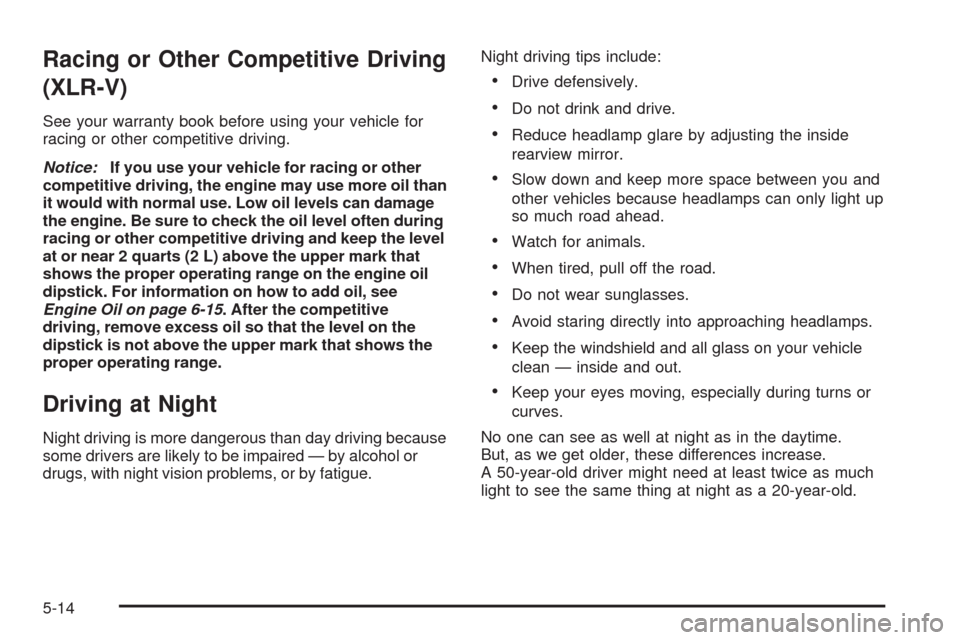
Racing or Other Competitive Driving
(XLR-V)
See your warranty book before using your vehicle for
racing or other competitive driving.
Notice:If you use your vehicle for racing or other
competitive driving, the engine may use more oil than
it would with normal use. Low oil levels can damage
the engine. Be sure to check the oil level often during
racing or other competitive driving and keep the level
at or near 2 quarts (2 L) above the upper mark that
shows the proper operating range on the engine oil
dipstick. For information on how to add oil, see
Engine Oil on page 6-15. After the competitive
driving, remove excess oil so that the level on the
dipstick is not above the upper mark that shows the
proper operating range.
Driving at Night
Night driving is more dangerous than day driving because
some drivers are likely to be impaired — by alcohol or
drugs, with night vision problems, or by fatigue.Night driving tips include:
Drive defensively.
Do not drink and drive.
Reduce headlamp glare by adjusting the inside
rearview mirror.
Slow down and keep more space between you and
other vehicles because headlamps can only light up
so much road ahead.
Watch for animals.
When tired, pull off the road.
Do not wear sunglasses.
Avoid staring directly into approaching headlamps.
Keep the windshield and all glass on your vehicle
clean — inside and out.
Keep your eyes moving, especially during turns or
curves.
No one can see as well at night as in the daytime.
But, as we get older, these differences increase.
A 50-year-old driver might need at least twice as much
light to see the same thing at night as a 20-year-old.
5-14
Page 313 of 462

{CAUTION:
Snow can trap engine exhaust under the vehicle.
This may cause exhaust gases to get inside.
Engine exhaust contains carbon monoxide (CO)
which cannot be seen or smelled. It can cause
unconsciousness and even death.
If the vehicle is stuck in the snow:
Clear away snow from around the base of
your vehicle, especially any that is blocking
the exhaust pipe.
Check again from time to time to be sure
snow does not collect there.
Open a window about two inches on the side
of the vehicle that is away from the wind to
bring in fresh air.
Fully open the air outlets on or under the
instrument panel.
Adjust the Climate Control system to a setting
that circulates the air inside the vehicle and
set the fan speed to the highest setting.
See Climate Control System in the Index.
For more information about carbon monoxide,
seeEngine Exhaust on page 2-36.
CAUTION: (Continued)
CAUTION: (Continued)
Snow can trap exhaust gases under your vehicle.
This can cause deadly CO (carbon monoxide) gas
to get inside. CO could overcome you and kill you.
You cannot see it or smell it, so you might not
know it is in your vehicle. Clear away snow from
around the base of your vehicle, especially any
that is blocking the exhaust.
Run the engine for short periods only as needed to
keep warm, but be careful.
To save fuel, run the engine for only short periods as
needed to warm the vehicle and then shut the engine off
and close the window most of the way to save heat.
Repeat this until help arrives but only when you
feel really uncomfortable from the cold. Moving about to
keep warm also helps.
If it takes some time for help to arrive, now and then
when you run the engine, push the accelerator
pedal slightly so the engine runs faster than the idle
speed. This keeps the battery charged to restart
the vehicle and to signal for help with the headlamps.
Do this as little as possible to save fuel.
5-19
Page 325 of 462
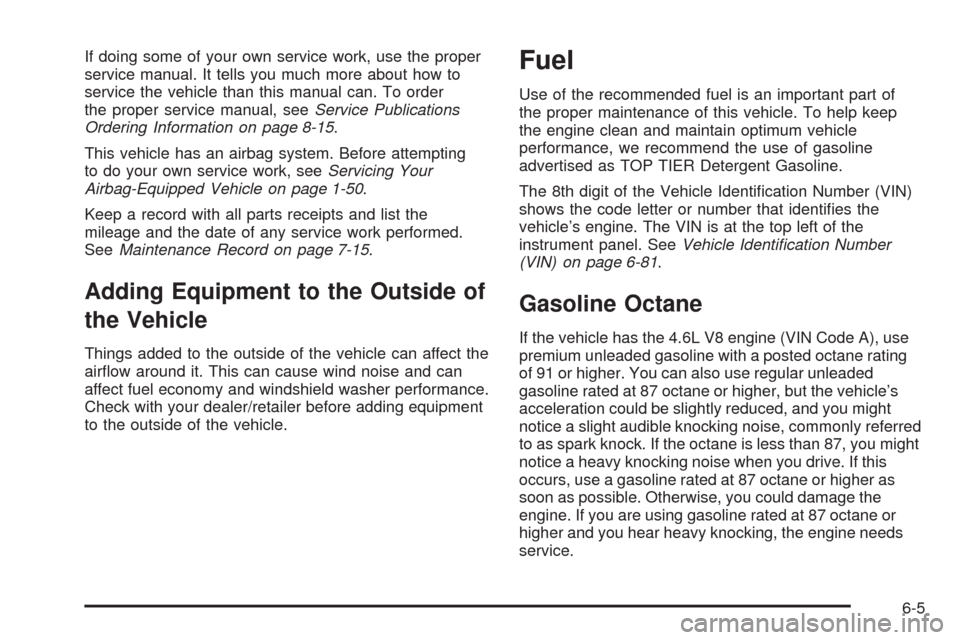
If doing some of your own service work, use the proper
service manual. It tells you much more about how to
service the vehicle than this manual can. To order
the proper service manual, seeService Publications
Ordering Information on page 8-15.
This vehicle has an airbag system. Before attempting
to do your own service work, seeServicing Your
Airbag-Equipped Vehicle on page 1-50.
Keep a record with all parts receipts and list the
mileage and the date of any service work performed.
SeeMaintenance Record on page 7-15.
Adding Equipment to the Outside of
the Vehicle
Things added to the outside of the vehicle can affect the
air�ow around it. This can cause wind noise and can
affect fuel economy and windshield washer performance.
Check with your dealer/retailer before adding equipment
to the outside of the vehicle.
Fuel
Use of the recommended fuel is an important part of
the proper maintenance of this vehicle. To help keep
the engine clean and maintain optimum vehicle
performance, we recommend the use of gasoline
advertised as TOP TIER Detergent Gasoline.
The 8th digit of the Vehicle Identi�cation Number (VIN)
shows the code letter or number that identi�es the
vehicle’s engine. The VIN is at the top left of the
instrument panel. SeeVehicle Identification Number
(VIN) on page 6-81.
Gasoline Octane
If the vehicle has the 4.6L V8 engine (VIN Code A), use
premium unleaded gasoline with a posted octane rating
of 91 or higher. You can also use regular unleaded
gasoline rated at 87 octane or higher, but the vehicle’s
acceleration could be slightly reduced, and you might
notice a slight audible knocking noise, commonly referred
to as spark knock. If the octane is less than 87, you might
notice a heavy knocking noise when you drive. If this
occurs, use a gasoline rated at 87 octane or higher as
soon as possible. Otherwise, you could damage the
engine. If you are using gasoline rated at 87 octane or
higher and you hear heavy knocking, the engine needs
service.
6-5
Page 357 of 462
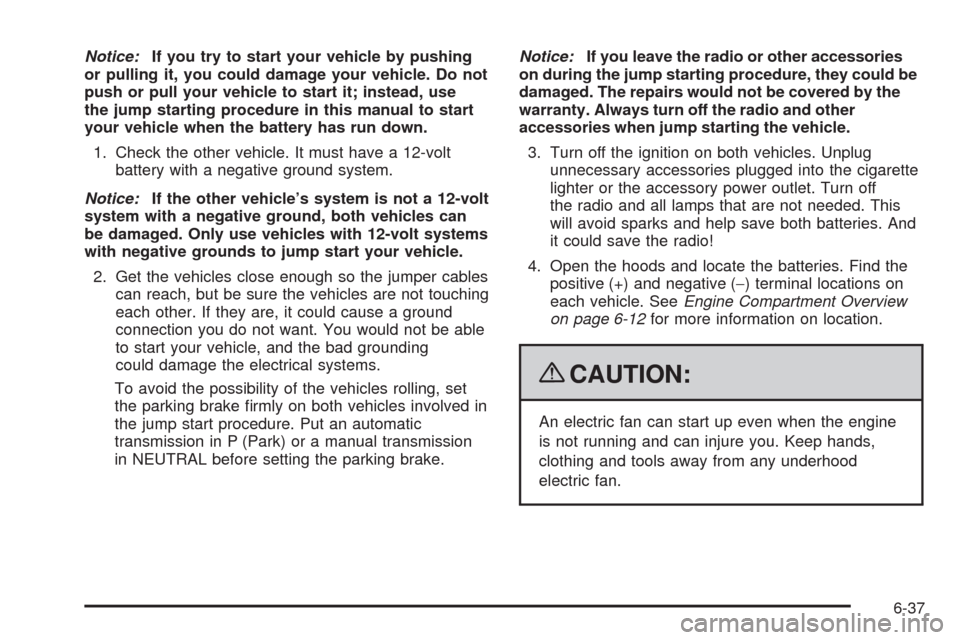
Notice:If you try to start your vehicle by pushing
or pulling it, you could damage your vehicle. Do not
push or pull your vehicle to start it; instead, use
the jump starting procedure in this manual to start
your vehicle when the battery has run down.
1. Check the other vehicle. It must have a 12-volt
battery with a negative ground system.
Notice:If the other vehicle’s system is not a 12-volt
system with a negative ground, both vehicles can
be damaged. Only use vehicles with 12-volt systems
with negative grounds to jump start your vehicle.
2. Get the vehicles close enough so the jumper cables
can reach, but be sure the vehicles are not touching
each other. If they are, it could cause a ground
connection you do not want. You would not be able
to start your vehicle, and the bad grounding
could damage the electrical systems.
To avoid the possibility of the vehicles rolling, set
the parking brake �rmly on both vehicles involved in
the jump start procedure. Put an automatic
transmission in P (Park) or a manual transmission
in NEUTRAL before setting the parking brake.Notice:If you leave the radio or other accessories
on during the jump starting procedure, they could be
damaged. The repairs would not be covered by the
warranty. Always turn off the radio and other
accessories when jump starting the vehicle.
3. Turn off the ignition on both vehicles. Unplug
unnecessary accessories plugged into the cigarette
lighter or the accessory power outlet. Turn off
the radio and all lamps that are not needed. This
will avoid sparks and help save both batteries. And
it could save the radio!
4. Open the hoods and locate the batteries. Find the
positive (+) and negative (−) terminal locations on
each vehicle. SeeEngine Compartment Overview
on page 6-12for more information on location.
{CAUTION:
An electric fan can start up even when the engine
is not running and can injure you. Keep hands,
clothing and tools away from any underhood
electric fan.
6-37
Page 358 of 462
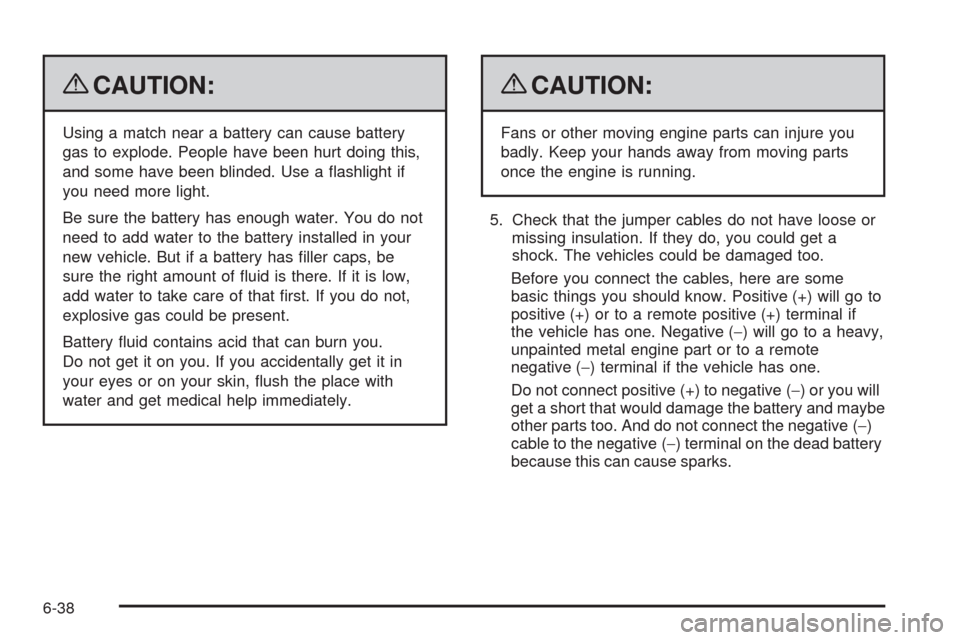
{CAUTION:
Using a match near a battery can cause battery
gas to explode. People have been hurt doing this,
and some have been blinded. Use a �ashlight if
you need more light.
Be sure the battery has enough water. You do not
need to add water to the battery installed in your
new vehicle. But if a battery has �ller caps, be
sure the right amount of �uid is there. If it is low,
add water to take care of that �rst. If you do not,
explosive gas could be present.
Battery �uid contains acid that can burn you.
Do not get it on you. If you accidentally get it in
your eyes or on your skin, �ush the place with
water and get medical help immediately.
{CAUTION:
Fans or other moving engine parts can injure you
badly. Keep your hands away from moving parts
once the engine is running.
5. Check that the jumper cables do not have loose or
missing insulation. If they do, you could get a
shock. The vehicles could be damaged too.
Before you connect the cables, here are some
basic things you should know. Positive (+) will go to
positive (+) or to a remote positive (+) terminal if
the vehicle has one. Negative (−) will go to a heavy,
unpainted metal engine part or to a remote
negative (−) terminal if the vehicle has one.
Do not connect positive (+) to negative (−) or you will
get a short that would damage the battery and maybe
other parts too. And do not connect the negative (−)
cable to the negative (−) terminal on the dead battery
because this can cause sparks.
6-38
Page 419 of 462
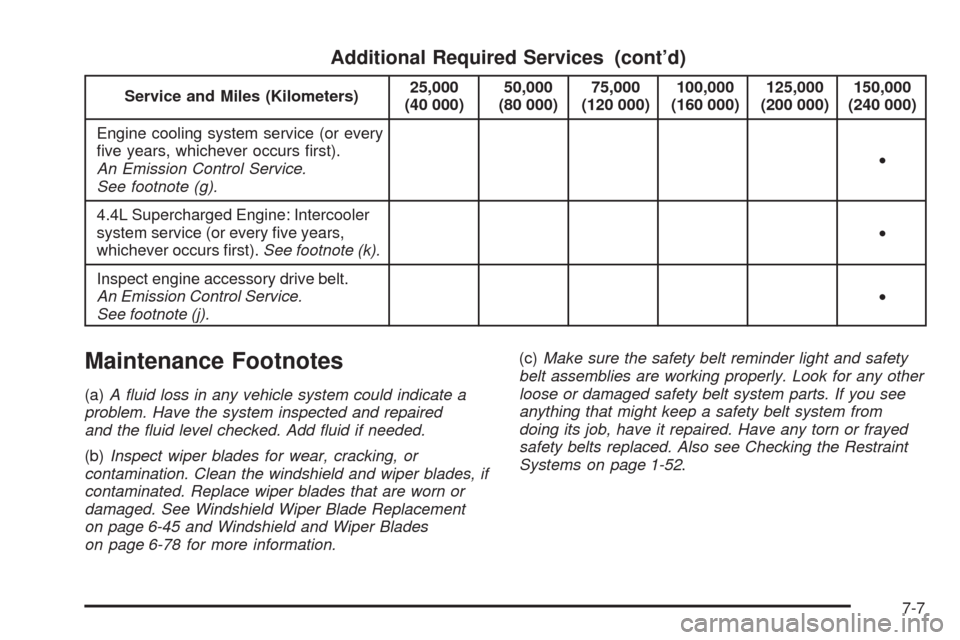
Additional Required Services (cont’d)
Service and Miles (Kilometers)25,000
(40 000)50,000
(80 000)75,000
(120 000)100,000
(160 000)125,000
(200 000)150,000
(240 000)
Engine cooling system service (or every
�ve years, whichever occurs �rst).
An Emission Control Service.
See footnote (g).•
4.4L Supercharged Engine: Intercooler
system service (or every �ve years,
whichever occurs �rst).See footnote (k).•
Inspect engine accessory drive belt.
An Emission Control Service.
See footnote (j).•
Maintenance Footnotes
(a)A fluid loss in any vehicle system could indicate a
problem. Have the system inspected and repaired
and the fluid level checked. Add fluid if needed.
(b)Inspect wiper blades for wear, cracking, or
contamination. Clean the windshield and wiper blades, if
contaminated. Replace wiper blades that are worn or
damaged. See Windshield Wiper Blade Replacement
on page 6-45 and Windshield and Wiper Blades
on page 6-78 for more information.(c)Make sure the safety belt reminder light and safety
belt assemblies are working properly. Look for any other
loose or damaged safety belt system parts. If you see
anything that might keep a safety belt system from
doing its job, have it repaired. Have any torn or frayed
safety belts replaced. Also see Checking the Restraint
Systems on page 1-52.
7-7
Page 451 of 462
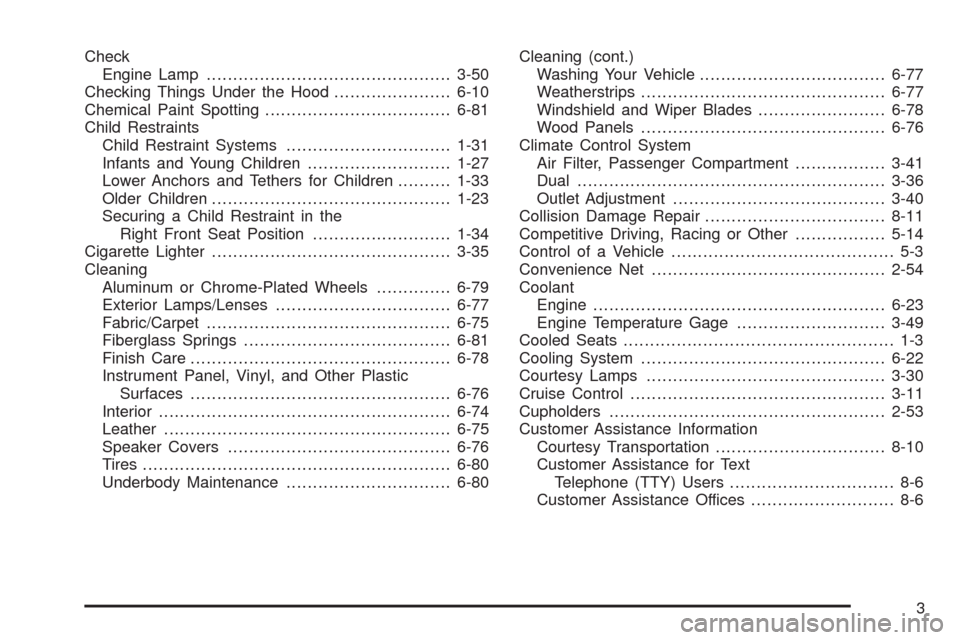
Check
Engine Lamp..............................................3-50
Checking Things Under the Hood......................6-10
Chemical Paint Spotting...................................6-81
Child Restraints
Child Restraint Systems...............................1-31
Infants and Young Children...........................1-27
Lower Anchors and Tethers for Children..........1-33
Older Children.............................................1-23
Securing a Child Restraint in the
Right Front Seat Position..........................1-34
Cigarette Lighter.............................................3-35
Cleaning
Aluminum or Chrome-Plated Wheels..............6-79
Exterior Lamps/Lenses.................................6-77
Fabric/Carpet..............................................6-75
Fiberglass Springs.......................................6-81
Finish Care.................................................6-78
Instrument Panel, Vinyl, and Other Plastic
Surfaces.................................................6-76
Interior.......................................................6-74
Leather......................................................6-75
Speaker Covers..........................................6-76
Tires..........................................................6-80
Underbody Maintenance...............................6-80Cleaning (cont.)
Washing Your Vehicle...................................6-77
Weatherstrips..............................................6-77
Windshield and Wiper Blades........................6-78
Wood Panels..............................................6-76
Climate Control System
Air Filter, Passenger Compartment.................3-41
Dual ..........................................................3-36
Outlet Adjustment........................................3-40
Collision Damage Repair..................................8-11
Competitive Driving, Racing or Other.................5-14
Control of a Vehicle.......................................... 5-3
Convenience Net............................................2-54
Coolant
Engine.......................................................
6-23
Engine Temperature Gage............................3-49
Cooled Seats................................................... 1-3
Cooling System..............................................6-22
Courtesy Lamps.............................................3-30
Cruise Control................................................3-11
Cupholders....................................................2-53
Customer Assistance Information
Courtesy Transportation................................8-10
Customer Assistance for Text
Telephone (TTY) Users............................... 8-6
Customer Assistance Offices........................... 8-6
3
Page 453 of 462
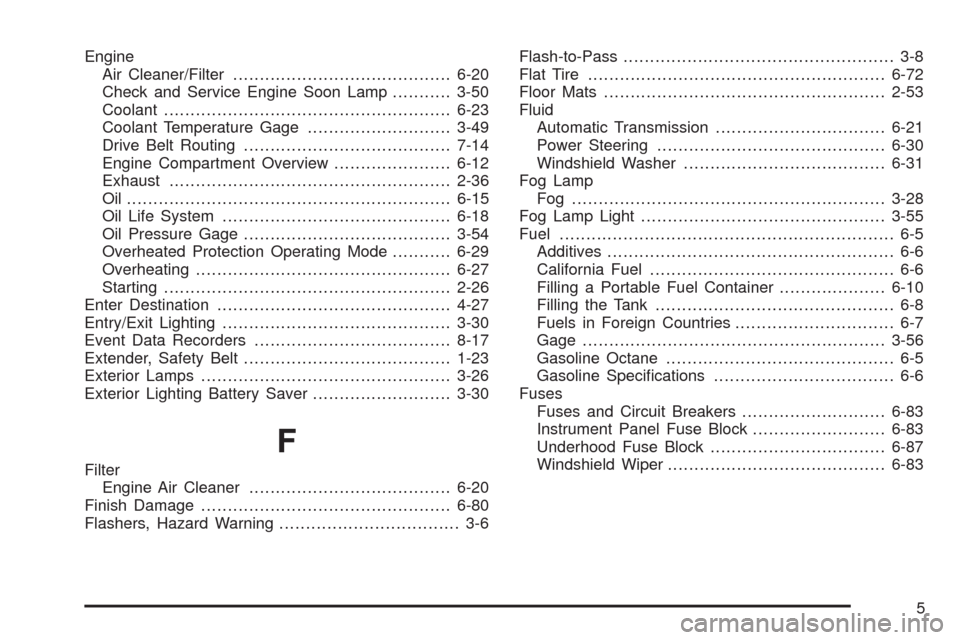
Engine
Air Cleaner/Filter.........................................6-20
Check and Service Engine Soon Lamp...........3-50
Coolant......................................................6-23
Coolant Temperature Gage...........................3-49
Drive Belt Routing.......................................7-14
Engine Compartment Overview......................6-12
Exhaust.....................................................2-36
Oil .............................................................6-15
Oil Life System...........................................6-18
Oil Pressure Gage.......................................3-54
Overheated Protection Operating Mode...........6-29
Overheating................................................6-27
Starting......................................................2-26
Enter Destination............................................4-27
Entry/Exit Lighting...........................................3-30
Event Data Recorders.....................................8-17
Extender, Safety Belt.......................................1-23
Exterior Lamps...............................................3-26
Exterior Lighting Battery Saver..........................3-30
F
Filter
Engine Air Cleaner......................................6-20
Finish Damage...............................................6-80
Flashers, Hazard Warning.................................. 3-6Flash-to-Pass................................................... 3-8
Flat Tire........................................................6-72
Floor Mats.....................................................2-53
Fluid
Automatic Transmission................................6-21
Power Steering...........................................6-30
Windshield Washer......................................6-31
Fog Lamp
Fog ...........................................................3-28
Fog Lamp Light..............................................3-55
Fuel............................................................... 6-5
Additives...................................................... 6-6
California Fuel.............................................. 6-6
Filling a Portable Fuel Container....................6-10
Filling the Tank............................................. 6-8
Fuels in Foreign Countries.............................. 6-7
Gage .........................................................3-56
Gasoline Octane........................................... 6-5
Gasoline Speci�cations.................................. 6-6
Fuses
Fuses and Circuit Breakers...........................6-83
Instrument Panel Fuse Block.........................6-83
Underhood Fuse Block.................................6-87
Windshield Wiper.........................................6-83
5
Page 454 of 462
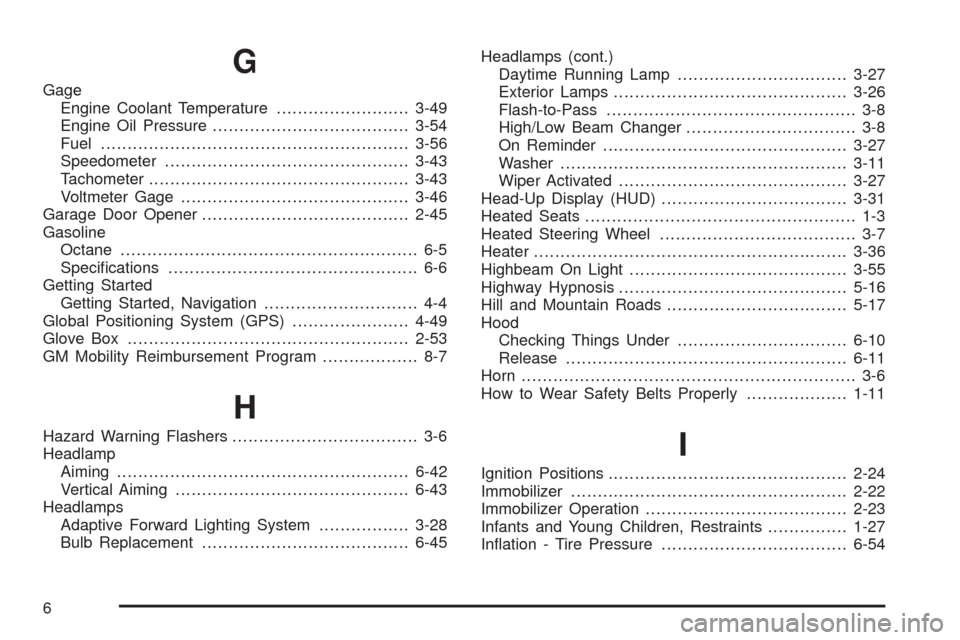
G
Gage
Engine Coolant Temperature.........................3-49
Engine Oil Pressure.....................................3-54
Fuel..........................................................3-56
Speedometer..............................................3-43
Tachometer.................................................3-43
Voltmeter Gage...........................................3-46
Garage Door Opener.......................................2-45
Gasoline
Octane........................................................ 6-5
Speci�cations............................................... 6-6
Getting Started
Getting Started, Navigation............................. 4-4
Global Positioning System (GPS)......................4-49
Glove Box.....................................................2-53
GM Mobility Reimbursement Program.................. 8-7
H
Hazard Warning Flashers................................... 3-6
Headlamp
Aiming .......................................................6-42
Vertical Aiming............................................6-43
Headlamps
Adaptive Forward Lighting System.................3-28
Bulb Replacement.......................................6-45Headlamps (cont.)
Daytime Running Lamp................................3-27
Exterior Lamps............................................3-26
Flash-to-Pass............................................... 3-8
High/Low Beam Changer................................ 3-8
On Reminder..............................................3-27
Washer......................................................3-11
Wiper Activated...........................................3-27
Head-Up Display (HUD)...................................3-31
Heated Seats................................................... 1-3
Heated Steering Wheel..................................... 3-7
Heater...........................................................3-36
Highbeam On Light.........................................3-55
Highway Hypnosis...........................................5-16
Hill and Mountain Roads..................................5-17
Hood
Checking Things Under................................6-10
Release.....................................................6-11
Horn ............................................................... 3-6
How to Wear Safety Belts Properly...................1-11I
Ignition Positions.............................................2-24
Immobilizer....................................................2-22
Immobilizer Operation......................................2-23
Infants and Young Children, Restraints...............1-27
In�ation - Tire Pressure...................................6-54
6